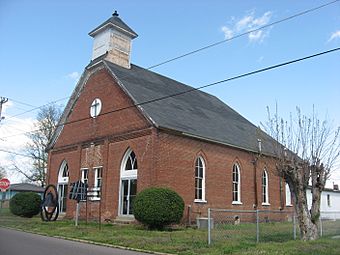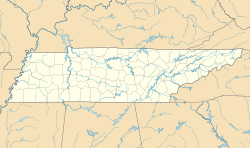Mt. Zion Christian Methodist Episcopal Church facts for kids
Quick facts for kids |
|
|
Mt. Zion Colored Methodist Episcopal Church
|
|

Front and southern side
|
|
| Location | Corner of North Greenwood and East College Streets, Union City, Tennessee |
|---|---|
| Area | 1 acre (0.40 ha) |
| Built | 1896 |
| Architectural style | Gothic Revival |
| MPS | Union City, Tennessee MPS |
| NRHP reference No. | 01000140 |
| Added to NRHP | February 16, 2001 |
The Mt. Zion Christian Methodist Episcopal Church is a special old church in Union City, Tennessee. You can find it at the corner of North Greenwood and East College Streets. It used to be called the Mt. Zion Colored Methodist Episcopal Church. This church has a long history, especially for the African-American community in the area.
Contents
A Church with History
How the Church Started
The Mt. Zion church group began in 1870. This was the same year that the Colored Methodist Episcopal Church was formed. This new church group was created by African Americans who had been part of another church called the Methodist Episcopal Church, South.
In its early years, the Mt. Zion group met in a simple wooden church. This church was in the African-American neighborhood of Union City.
Building a New Home
By the 1890s, more people joined the church. Its members also became more successful. So, they decided to build a bigger church made of brick. Church members helped build the new church themselves. It was finished and opened in 1896. The church's design is a simpler version of the Gothic Revival style. This style was very popular in the late 1800s.
Inside the Church
The Main Sanctuary
The original brick building from 1896 holds the church's main worship area, called the sanctuary. It has a balanced design with pointed roof ends and a bell tower.
One interesting part of the inside is its unique ceiling. This ceiling is shaped like a hip and is about 30 feet above the floor. It has three sections made of narrow wooden planks. The middle section is flat, while the side sections angle down to the brick walls.
Lighting and Seating
The sanctuary gets its light from four old-fashioned metal light fixtures. These fixtures were made during the Victorian-era. They were first designed for gas lighting but were changed to use electricity around 1920. Each fixture has sixteen light bulbs. A large round shade above the bulbs helps direct the light.
As of 1996, the church still had its original pews. These are the long benches where people sit. The ends of the pews have decorations that look like Gothic arches. These arches match the shape of the church windows.
Community Hub
Supporting Education
In 1917, the Mt. Zion church helped build a new school for African-American children. This new brick school was named Miles School. It was built on North Greenwood Street, right across from the church.
The church and the school worked together. They were very important centers for the local African-American community. The first Miles School building was replaced by a newer one in the 1950s or 1960s. However, the location continued to be used for Union City's segregated black school. Today, this location is still used for education. As of 2014, it is the site of the Miles Early Head Start center.
Changes Over Time
Around 1940, a building for community events and classrooms was added to the back of the church. In 1956, the church's main group changed its name from "Colored Methodist Episcopal" to "Christian Methodist Episcopal." Because of this, the Mt. Zion church also adopted its current name.
The church group stopped meeting in 2005. But it started up again in 2007. Darrell Turner, who grew up in the church, became its leader.
A Historic Landmark
The Mt. Zion church was added to the National Register of Historic Places in 2001. It was recognized as Union City's "oldest remaining architectural artifact of African-American craftsmanship of the late Victorian era." This means it's a very important old building that shows the skill of African-American builders from that time.



